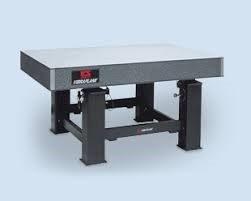Jeffrey A. Zapfe
Higher Education | Market Principal
Principal

If you have even been through a university optics lab you have probably encountered an optical table supported by air springs.

Optical tables are designed to be extremely stiff, something that is required to maintain the alignment of the various lasers, mirrors, and lenses used in the experiment. If you were to cut an optical table open, you would find two steel facesheets, separated by a lightweight honeycomb core. The concept is exactly the same as corrugated cardboard, only on a massively stiff scale.
The low vibration environment on the table is enhanced by a high-performance vibration isolation system which is typically an air spring (also known as a pneumatic isolator).
The mass of the optical table (including whatever is on the table) coupled with the stiffness of the springs creates a resonant system with a characteristic natural frequency. The natural frequency is given by the equation:
Fn=1/2π √(K/M)
The natural frequency for most commercial air springs is about 1 Hz which is a very soft spring. If the air spring was replaced by a conventional coil spring it would deflect by almost 10 inches under the weight of the table. The reason the air springs don’t deflect this much is they have a valve that increases the pressure in the leg to compensate for the weight of the table. If weight is added to the table, the pressure in the legs will increase to compensate.
In the spring equation, you can see what happens when the mass increases. If the spring stiffness is fixed (like a bungee cord) an increase in mass will lower the natural frequency. Air springs are different. An increase in mass also causes the pressure in the leg to increase (because of the leveling valve). But the air spring’s stiffness is also directly proportional to the air pressure. The cool thing is the pressure and stiffness are both directly related to the mass. This means if the mass doubles, the pressure also doubles which means the stiffness doubles. The net effect is the ratio of K/M does not change which means the natural frequency of an air spring is constant, no matter what the load on the table.
Very cool indeed.